

Pour un rétro-Design de l’attention. La prise en compte de l’expérience utilisateur par les systèmes numériques pose la question de l’attention de ceux qui sont amenés à les utiliser.

Comme l’a très bien pointé le designer Tristan Harris dans son article « Comment la technologie pirate l’esprit des gens », les services et produits numériques portent la question de la conception comportementale à des niveaux de sophistication inédits, notamment en s’appuyant sur l’exploitation de nos biais cognitifs et de nos interactions sociales, puissants moteurs d’activation de nos comportements. Il montre comment le design « capte », « accroche » les utilisateurs en stimulant leurs comportements. Trop souvent, la seule réponse qu’obtiennent les utilisateurs à ces problèmes attentionnels est qu’elle relève de leur responsabilité, alors que des milliers de designers agencent toujours plus finement la frontière entre l’incitation et la manipulation, en façonnant chaque boucle de rétroaction du moindre de leurs outils.
Prof. Nick Bostrom - Artificial Intelligence Will be The Greatest Revolution in History. Three Cognitive Dimensions for Tracking Deep Learning Progress. A common unexamined assumption about the evolution of AGI, that is self-aware sentient automation, will follow the path of ever more intelligent machines and thus accelerate towards a super intelligence once human level sentient automation is created.
I argue that this likely will not be the case and that there will be a initial divergence in research on three kinds of artificial general intelligences. A recent research paper titled “Morphospace of Consciousness” by Ariswalla et al. present 3 distinct dimensions to explore consciousness. These are: autonomous, computational and social. The autonomous dimension reflects the adaptive intelligence found in biological organisms. The computation dimension involves the recognition, planning and decision making capabilities that we find in computers as well as in humans. 1506.05869v2. New Theory Cracks Open the Black Box of Deep Neural Networks. Intelligence. Deep Learning is Splitting into Two Divergent Paths. Are Biological Brains Just Made up of NAND Gates? – Intuition Machine – Medium. I’ve come up with perhaps a controversial opinion as to how biological brains work.
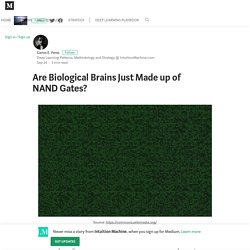
I am posting this to facilitate more discussion. I have two opinions, the second more surprising than the first. New Theory Cracks Open the Black Box of Deep Neural Networks. Three Cognitive Dimensions for Tracking Deep Learning Progress. Forget Killer Robots—Bias Is the Real AI Danger - MIT Technology Review. Google’s AI chief isn’t fretting about super-intelligent killer robots.
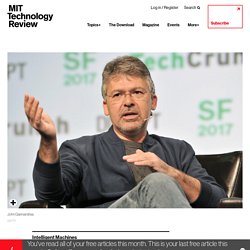
Instead, John Giannandrea is concerned about the danger that may be lurking inside the machine-learning algorithms used to make millions of decisions every minute. “The real safety question, if you want to call it that, is that if we give these systems biased data, they will be biased,” Giannandrea said before a recent Google conference on the relationship between humans and AI systems. The problem of bias in machine learning is likely to become more significant as the technology spreads to critical areas like medicine and law, and as more people without a deep technical understanding are tasked with deploying it. Some experts warn that algorithmic bias is already pervasive in many industries, and that almost no one is making an effort to identify or correct it (see “Biased Algorithms Are Everywhere, and No One Seems to Care”). Giannandrea has good reason to highlight the potential for bias to creep into AI. AI needs a human touch to function at its highest level.
Io9.gizmodo. Monica Anderson - Slides from various presentations I've... L’intelligence artificielle va-t-elle rester impénétrable ? [1609.08144] Google's Neural Machine Translation System: Bridging the Gap between Human and Machine Translation. 1606.04199. P15 1166. Schuster97 BRNN. 1409.1259v2. 1409.0473v7. [1409.3215] Sequence to Sequence Learning with Neural Networks. Bengio03a. Science. Unsupervised icml2012. The Great A.I. Awakening. Four days later, a couple of hundred journalists, entrepreneurs and advertisers from all over the world gathered in Google’s London engineering office for a special announcement.
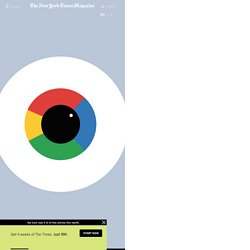
Guests were greeted with Translate-branded fortune cookies. Their paper slips had a foreign phrase on one side — mine was in Norwegian — and on the other, an invitation to download the Translate app. Tables were set with trays of doughnuts and smoothies, each labeled with a placard that advertised its flavor in German (zitrone), Portuguese (baunilha) or Spanish (manzana). After a while, everyone was ushered into a plush, dark theater. Photo Sadiq Khan, the mayor of London, stood to make a few opening remarks.
Pichai was in London in part to inaugurate Google’s new building there, the cornerstone of a new “knowledge quarter” under construction at King’s Cross, and in part to unveil the completion of the initial phase of a company transformation he announced last year. Until today. The new wave of A.I. 1. 2. 3. 4. Lecun 01a. Untitled. Eric Berlow and Sean Gourley: Mapping ideas worth spreading. 2012b ComCogSysMan rpwl final. Richard Loosemore. Stanford Center for Professional Development. We Need Algorithmic Angels. Editor’s note: Jarno M.

Koponen is a designer, humanist and co-founder of media discovery startup Random. His passion is to explore and create audacious human-centered digital experiences. A lot has been written on how algorithms are manipulating this and that in today’s Internet. However, there haven’t been many concrete proposals about how to create more human-centered algorithmic solutions. For example, do we need algorithms that are on our side? The lost algorithmic me Digital products are moving from our pockets to our skin and finally inside of us.
Facebook AI Director Yann LeCun on His Quest to Unleash Deep Learning and Make Machines Smarter. Artificial intelligence has gone through some dismal periods, which those in the field gloomily refer to as “AI winters.”

This is not one of those times; in fact, AI is so hot right now that tech giants like Google, Facebook, Apple, Baidu, and Microsoft are battling for the leading minds in the field. The current excitement about AI stems, in great part, from groundbreaking advances involving what are known as “convolutional neural networks.” This machine learning technique promises dramatic improvements in things like computer vision, speech recognition, and natural language processing. You probably have heard of it by its more layperson-friendly name: “Deep Learning.” Few people have been more closely associated with Deep Learning than Yann LeCun, 54. More recently, Deep Learning and its related fields grew to become one of the most active areas in computer research. Facebook AI Director Yann LeCun on His Quest to Unleash Deep Learning and Make Machines Smarter. Evolutionary Multiobjective Optimization.
Models vs. Patterns. A New Direction in Artificial Intelligence Research. Model Free Methods Workshop. Monica Anderson is CEO of Syntience Inc. and originator of a theory for "true" learning in animals, humans, and computers.
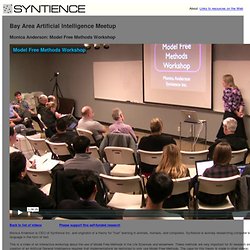
Syntience is actively researching computer based systems that can understand the meaning of language in the form of text. This is a video of an interactive workshop about the use of Model Free Methods in the Life Sciences and elsewhere. Artificial Intelligence Videos. How to Make a Mind. Can nonbiological brains have real minds of their own?
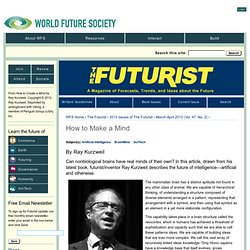
In this article, drawn from his latest book, futurist/inventor Ray Kurzweil describes the future of intelligence—artificial and otherwise. Artificial Intelligence.